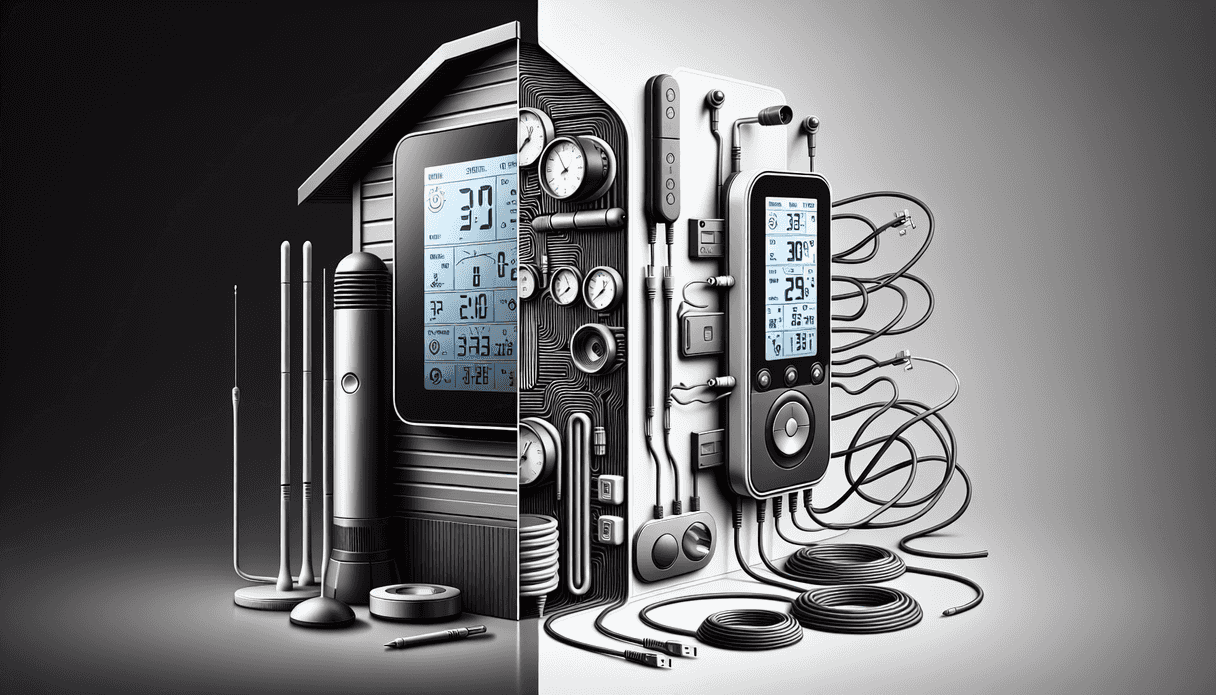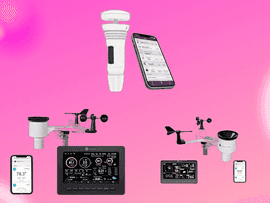Home weather stations have become an indispensable tool for weather enthusiasts, hobbyists, and professionals alike. With the advancement of technology, these devices have evolved to provide more accurate and comprehensive weather data. One of the key decisions when purchasing a home weather station is choosing between a wireless and a wired model. In this blog post, we will compare wireless and wired home weather stations, highlighting their advantages and disadvantages, and provide recommendations for some of the best models available on the market.
Wireless Home Weather Stations
Wireless home weather stations have gained popularity due to their ease of installation and flexibility. These devices use wireless communication to transmit data from the sensors to the display unit, eliminating the need for cumbersome cables.
Advantages of Wireless Home Weather Stations
- Ease of Installation: Wireless weather stations are relatively easy to set up. Since there are no cables to run, you can place the sensors in optimal locations without worrying about wiring.
- Flexibility: The absence of wires allows for greater flexibility in sensor placement. You can position the sensors in different locations to get more accurate readings.
- Aesthetics: Wireless weather stations offer a cleaner and more aesthetically pleasing setup. There are no cables to clutter your space.
- Portability: These devices are portable and can be easily moved to different locations if needed.
Disadvantages of Wireless Home Weather Stations
- Battery Dependency: Wireless sensors typically rely on batteries, which need to be replaced periodically. This can be an inconvenience, especially in remote or hard-to-reach locations.
- Signal Interference: Wireless signals can be affected by interference from other electronic devices, walls, and other obstacles, potentially impacting the accuracy and reliability of the data.
- Range Limitations: The range of wireless communication can be limited, especially in larger properties. This may require the use of signal repeaters or boosters.
Recommended Wireless Home Weather Stations
-
Ambient Weather WS-2902C WiFi Smart Weather Station
- Price: $189.99
- Features: Highly accurate sensors, enhanced WiFi connectivity, sturdy build quality, easy-to-read LCD display, comprehensive sensor array.
- Pros: Exceptional accuracy, robust connectivity, durable construction.
- Cons: Battery dependency for sensors.
- Buy on Amazon: Ambient Weather WS-2902C WiFi Smart Weather Station
-
WeatherFlow Tempest Weather System
- Price: $119.99
- Features: High accuracy, smart home integration, durable design, intuitive app interface, comprehensive sensors.
- Pros: Advanced machine learning algorithms, seamless connectivity, robust design.
- Cons: Requires app for display.
- Buy on Amazon: WeatherFlow Tempest Weather System
-
Netatmo Weather Station Indoor Outdoor
- Price: $179.99
- Features: Accurate weather data, smart home integration, real-time notifications, durable aluminum design, comprehensive sensors.
- Pros: Smart home integration, robust connectivity, sleek design.
- Cons: No physical display, app-based only.
- Buy on Amazon: Netatmo Weather Station Indoor Outdoor
Wired Home Weather Stations
Wired home weather stations use cables to connect the sensors to the display unit. While they may seem less convenient compared to wireless models, they offer their own set of advantages.
Advantages of Wired Home Weather Stations
- Reliability: Wired connections are less susceptible to interference and signal loss, providing more reliable and consistent data transmission.
- Power Supply: Wired sensors are often powered directly through the connection cable, eliminating the need for batteries and reducing maintenance.
- Accuracy: The direct connection can result in more accurate and timely data readings, as there is no potential for wireless signal delays.
Disadvantages of Wired Home Weather Stations
- Installation Complexity: Installing a wired weather station can be more challenging, especially if you need to run cables through walls or over long distances.
- Limited Flexibility: The placement of sensors is restricted by the length of the cables, which can limit your ability to position them in optimal locations.
- Aesthetics: The presence of cables can be less aesthetically pleasing and may require careful planning to hide or manage them.
Recommended Wired Home Weather Stations
-
Davis Instruments 6250 Vantage Vue Weather Station
- Price: $337.99
- Features: High accuracy, robust wireless connectivity, durable construction, comprehensive sensors, solar-powered.
- Pros: High-quality sensors, reliable data transmission, solar-powered.
- Cons: Higher price point, display sold separately.
- Buy on Amazon: Davis Instruments 6250 Vantage Vue Weather Station
-
AcuRite 01024M Pro Weather Station
- Price: $189.99
- Features: Highly accurate sensors, stable remote access, durable construction, clear auto-dimming display, comprehensive sensor suite.
- Pros: Comprehensive sensor suite, clear display, stable connectivity.
- Cons: Requires careful installation of wired connections.
- Buy on Amazon: AcuRite 01024M Pro Weather Station
Hybrid Weather Stations
Some weather stations offer a hybrid approach, combining both wired and wireless elements to leverage the advantages of both systems. These models typically use wired connections for critical sensors and wireless connections for additional sensors or remote displays.
Recommended Hybrid Weather Stations
- Ambient Weather WS-2000 Smart Weather Station
- Price: $299.99
- Features: Highly reliable sensors, enhanced Wi-Fi connectivity, durable construction, customizable TFT display, comprehensive sensor array.
- Pros: Exceptional accuracy, robust connectivity, customizable display.
- Cons: Higher price point.
- Buy on Amazon: Ambient Weather WS-2000 Smart Weather Station
Conclusion
Choosing between a wireless and a wired home weather station ultimately depends on your specific needs and preferences. Wireless weather stations offer ease of installation, flexibility, and a cleaner setup, making them ideal for most home users. However, they do come with potential drawbacks such as battery dependency and signal interference.
On the other hand, wired weather stations provide reliable data transmission and eliminate the need for batteries, but they require more complex installation and may have limited sensor placement options.
For those who want the best of both worlds, hybrid weather stations offer a balanced approach, combining the reliability of wired connections with the flexibility of wireless sensors.
Regardless of your choice, investing in a high-quality weather station can greatly enhance your ability to monitor and understand the weather, providing valuable insights and data for both personal and professional use.
Explore more detailed reviews and purchase options for the recommended weather stations:
- Ambient Weather WS-2902C WiFi Smart Weather Station | Buy on Amazon
- WeatherFlow Tempest Weather System | Buy on Amazon
- Netatmo Weather Station Indoor Outdoor | Buy on Amazon
- Davis Instruments 6250 Vantage Vue Weather Station | Buy on Amazon
- AcuRite 01024M Pro Weather Station | Buy on Amazon
- Ambient Weather WS-2000 Smart Weather Station | Buy on Amazon





